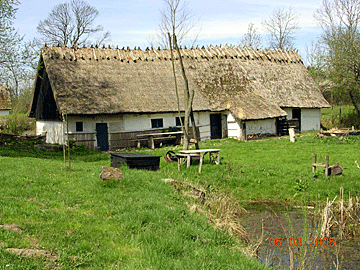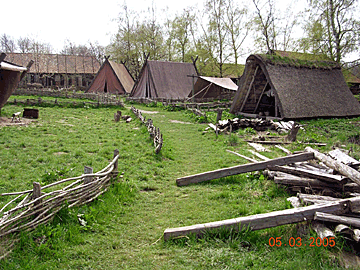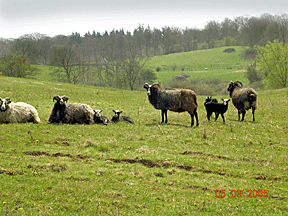The
Village Where the Past is Present
by Bob Brooke
 The
sun shines full and wispy clouds float over a group of thatched houses
standing by a pond surrounded by a cross-timber fence. The scene seems
to be from another time. In a way it is. The houses are part of an Iron
Age village near the town of Lejre, 25 miles west of Copenhagen,
Denmark. The
sun shines full and wispy clouds float over a group of thatched houses
standing by a pond surrounded by a cross-timber fence. The scene seems
to be from another time. In a way it is. The houses are part of an Iron
Age village near the town of Lejre, 25 miles west of Copenhagen,
Denmark.
A group of Scandinavian scientists,
passionate explorers of the past, have built this village to find out
how people lived in northern Europe during prehistoric times. Basing
their work on solid archeological evidence, they set about constructing
duplicates of Iron Age dwellings that have been uncovered, tilling
fields with copies of ancient plows, weaving cloth on reconstructions of
prehistoric looms and turning it into clothing–all with the goal of
experimentation to prove their theories.
In one experiment, they
set fire to one of the reconstructed houses to see how closely its ruins
matched the charred remains of actual Iron Age houses. They discovered
exactly how prehistoric man built his houses, how he used his tools and
how many acres of grain it took to feed a family of six or eight.
 This re-created village
of the early Iron Age–from about 500 B.C. to 400 A.D.–is the focus
of a living experiment in prehistory at the research center at Lejre,
founded in 1964, which today spreads over 50 acres of Danish fields and
woodlands. This re-created village
of the early Iron Age–from about 500 B.C. to 400 A.D.–is the focus
of a living experiment in prehistory at the research center at Lejre,
founded in 1964, which today spreads over 50 acres of Danish fields and
woodlands.
No mere tourist
attraction, this village is a working laboratory. Here, aided by student
volunteers who live and sometimes dress like prehistoric farmers, the
Lejre scientists measure everything from the body heat given off by
animals stabled indoors to the length of time it takes for a thatched
wattle-and-daub house to disintegrate after it has been abandoned.
Nestled between marsh and
hill, the houses at Lejre, like their Iron Age counterparts, lie along
an east-west axis, with hearth and living quarters at the western end of
each and pens for livestock at the eastern end. An encircling branch
fence keeps grazing animals from nibbling at the thatch.
Ancient Food
Production
And the experimentation doesn't stop with dwellings. Scrupulously
scientific in duplicating the living conditions of Iron Age Danes, the
researchers at Lejre have also explore in detail the ancient methods of
food production. They test the efficiency of the prehistoric plow,
called an ard, in various kinds of soil, using draft animals that
closely approximate in size and appearance breeds believed to have been
used at the time.
In their plowed fields,
researchers plant the kinds of crops that, according to pollen analysis
and seed remains, Iron Age farmers sowed, including flax, barley and
emmer and einkorn wheat. In the autumn, they harvest their grains with
copies of ancient sickles.
After harvesting the
grain, volunteers thresh it in the passageway between the living
quarters and stable, where persistent drafts help blow away the chaff.
Then they crush it into flour, kneading it into bread and making it into
porridge. They found that to grind a day's worth of coarse meal took as
long as three hours to grind a day's worth of coarse meal. To do this,
young women kneel on a sheepskin which lies beneath the runner and the
rester, as the millstone are called. The sheepskin helps to keep the
dirt on the hard-packed clay floor from becoming mixed with the grain.
Overhead, cuts of meat, suspend from rafters to dry and cure, dangle in
the warm smoke of the hearth fire.
Volunteers store the
newly ground grain in a cloth-covered drying rack hung from the rafters
in the loft of the house. This keeps the grain out of the reach of
rodents. The smoke from the hearth, drifting through the loft, gives
added protection.
Loaves o f
"fireplace" bread baked in the ashes of the hearth fire have
been discovered at Iron Age settlements. There was little or no
furniture in Iron Age houses, so grinding, baking and most other work
had to be done while kneeling on the hard dirt floor.
Re-creating Ancient
Crafts
The Leyre researchers have painstakingly re-created ancient crafts. By
studying the style and the chemical structure of ancient pieces of
pottery and by experimenting with different techniques of firing,
potters have been able to produce accurate copies of the Iron Age
originals.
The potters then fire the
raw clay pots in a kiln similar to those used in northern Europe 2,500
years ago. Before they can do this, however, they must reconstruct the
kiln using clay that has been packed around a frame of twigs, which is
hardened by fire. The intense heat carried up by drafts from the
wood-filled firebox, at the bottom of the kiln, hardens the raw pottery
stacked inside the bulbous oven.
Similarly, drawing upon
information as diverse as loom weights dug up at archeological sites and
paintings on Greek vases, weavers at Lejre have reconstructed an upright
prehistoric loom and have used it to reproduce woolen Iron Age clothing.
Volunteers wear robes of
homespun identical to ancient garments. Replicas of ancient fabrics have
resulted from years of research, involving microscopic study o f Iron
Age textiles and the breeding o f special sheep to produce the proper
kind o f wool. Leyre researchers spend long hours spinning thread to the
right coarseness and strength and adjusting the loom so that the length
and number of threads correspond to those in the original cloth
 Researchers have also
experimented with animals. During part of one winter, they shared one of
the houses with the livestock, a common practice in prehistoric times,
based on horse and cattle bones found in charred house ruins. As the
researchers learned, the animals' body heat helped to make the chilly
house livable. Careful breeding experiments insured that the animals
used were similar to those of now-extinct breeds. Researchers produced a
hairy pig--hardy, quick and well adapted to living in the forest as its
ancestors were--by breeding farm pigs with wild boars. And when turned loose in the
Spring, they carefully observed the animals to see what impact they had
on the vegetation of nearby pastures and forests. Researchers have also
experimented with animals. During part of one winter, they shared one of
the houses with the livestock, a common practice in prehistoric times,
based on horse and cattle bones found in charred house ruins. As the
researchers learned, the animals' body heat helped to make the chilly
house livable. Careful breeding experiments insured that the animals
used were similar to those of now-extinct breeds. Researchers produced a
hairy pig--hardy, quick and well adapted to living in the forest as its
ancestors were--by breeding farm pigs with wild boars. And when turned loose in the
Spring, they carefully observed the animals to see what impact they had
on the vegetation of nearby pastures and forests.
Throughout the long, dark
months of the Scandinavian Iron Age winter, the hearth fire was the
center of activity. Huddled close to its meager warmth, women worked at
their weaving, did the cooking and ground
the grain, while the men prepared their farm tools for spring use, or
their weapons for an occasional morning's hunt.
Skins of oxen and horses
suspended over the fire helped keep flying sparks from reaching the dry
roof thatch. There was no chimney hole, which would have permitted rain
and snow to enter. Instead Iron Age home builders placed air holes under
the apex of the roof at either end of the house. The cross draft carried
the hearth smoke from one end of the dwelling, through the loft and out
the other opening. This also helped to draw the warmth of the livestock
into the living area.
Leyre stands as a
monument to scientific exploration. It's only through such experiments
that man can learn how his ancient ancestors lived.
< Back to Hans
Christian Andersen
|